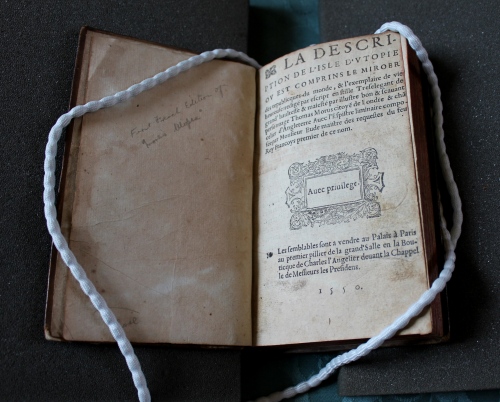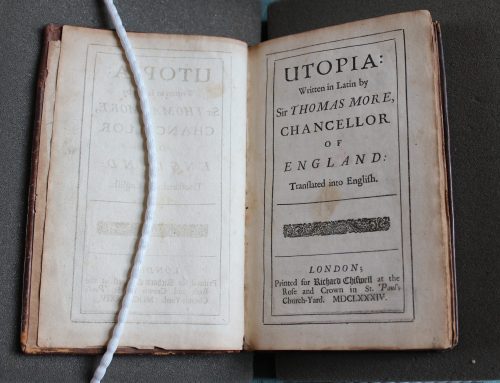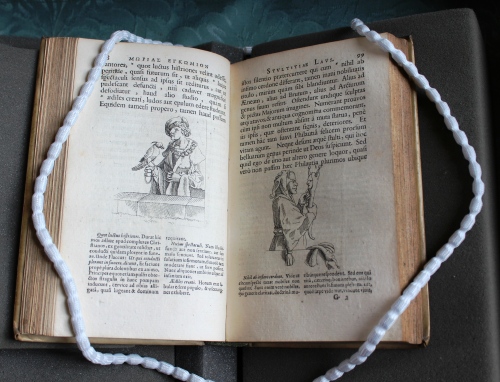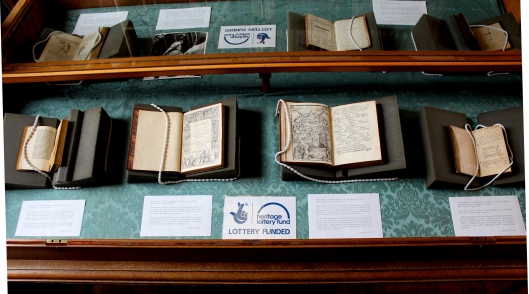To mark the 500th anniversary of the publication of Sir Thomas More’s Utopia (1516), King’s College Library mounted an exhibition showcasing rare early editions and translations of More’s seminal text. For those who did not have the opportunity to visit the exhibition, we provide here some selected highlights.
Below is a rare copy of the second of five Latin editions of Utopia that appeared during Thomas More’s lifetime. First published in Louvain in 1516, the book describes a fictional island society and its religious and social practices. More envisaged an independent community that shared a common culture and values.
The title translates as: “Of a republic’s best state and of the new island Utopia”. The story is set in the New World, and references to Amerigo Vespucci and his voyages are made on leaf iii.
![Thomas More, De optimo reipublicae statu, de[que] noua insula Vtopia [Paris]: Gilles de Gourmont, [1517] (Keynes.Ec.7.3.15)](https://kcctreasures.files.wordpress.com/2017/03/keynes-ec-7-3-15.jpg?w=500&h=381)
Thomas More, De optimo reipublicae statu, de[que] noua insula Vtopia
[Paris]: Gilles de Gourmont, [1517] (Keynes.Ec.7.3.15)
The third edition of More’s Utopia was printed in Switzerland in March 1518. The woodcut title-page border was made by Hans Holbein the Younger (ca. 1497-1543), who went to England in 1526 looking for work with a recommendation from Erasmus. He was received into the humanist circle of Thomas More, and painted his portrait in 1527.
![Thomas More, De optimo reip[ublicae] statu, deque noua insula Vtopia Basel: Johann Froben, March 1518 (Thackeray.J.46.7)](https://kcctreasures.files.wordpress.com/2017/03/thackeray-j-46-7.jpg?w=500&h=345)
Thomas More, De optimo reip[ublicae] statu, deque noua insula Vtopia
Basel: Johann Froben, March 1518 (Thackeray.J.46.7)
The fourth edition of More’s Utopia was printed in Switzerland in November 1518. The woodcut on p. [12] is by Ambrosius Holbein, who collaborated with his brother Hans Holbein the Younger on the illustrations to this book. In the lower left corner, Raphael Hythlodaeus, the main character in the book, describes the island Utopia.
On the opposite page is the Utopian 22-letter alphabet, featuring letters in the shape of a circle, square, and triangle. These correspond almost precisely to the 23-letter Latin alphabet.
![Thomas More, De optimo reip[ublicae] statu, deque noua insula Vtopia Basel: Johann Froben, November 1518 (Keynes.Ec7.03.17)](https://kcctreasures.files.wordpress.com/2017/03/keynes-ec7-03-17.jpg?w=500&h=316)
Thomas More, De optimo reip[ublicae] statu, deque noua insula Vtopia
Basel: Johann Froben, November 1518 (Keynes.Ec7.03.17)
The first French edition of More’s Utopia, translated by Jean Le Blond (1502-53), was illustrated with 12 woodcuts. Le Blond adapted the second Latin edition (1517), itself printed in Paris and the first edition to contain a letter by the French humanist Guillaume Budé, whom Erasmus defined as the “marvel of France”.

Thomas More, La Description de l’isle d’Vtopie ou est comprins le miroer des republicques du monde, & l’exemplaire de vie heureuse
Paris: Charles L’Angelier, 1550 (Keynes.Cc.02.04/1)
Utopia was first published in England as an English translation by Ralph Robinson in 1551, sixteen years after More’s execution. This is a rare copy of the second revised translation printed in 1556.
![Thomas More, A frutefull pleasaunt, & wittie worke, of the beste state of a publique weale, and of the newe yle, called Utopia London: [Richard Tottel for] Abraham Vele, [1556] (Keynes.Ec.7.3.18)](https://kcctreasures.files.wordpress.com/2017/03/keynes-ec-7-3-18.jpg?w=375&h=527)
Thomas More, A frutefull pleasaunt, & wittie worke, of the beste state of a publique weale, and of the newe yle, called Utopia
London: [Richard Tottel for] Abraham Vele, [1556] (Keynes.Ec.7.3.18)
The second major English translation of Utopia was undertaken by the Scottish philosopher and historian Gilbert Burnet (1643-1715), Bishop of Salisbury, in 1684. This is probably the most commonly quoted translation.

Utopia: Written in Latin by Sir Thomas More, Chancellor of England
London: Richard Chiswell, 1684 (Keynes.Cc.02.08)
Utopia was first printed in 1516 under the editorship of Erasmus, a good friend of Thomas More. One of Erasmus’s best-known works, The Praise of Folly (1511), published under the double title Moriae encomium (Greek, Latinised) and Laus stultitiae (Latin), was dedicated to More, on whose name the title puns.

Desiderius Erasmus, Mōrias enkōmion = Stultitiae laus
Basel: Johann Rudolph Genath, 1676 (Thackeray.J.46.6)
This edition contains 83 etchings by Caspar Merian after drawings by Hans Holbein the Younger in the margins of a 1515 edition of the book preserved in the Basel University Library. Page 99 features a witty drawing of Folly.
IJ




